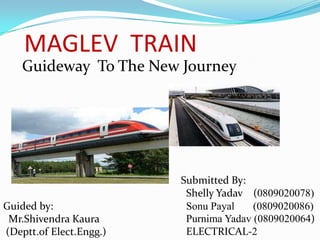
Maglev Train Ppt 1
- 1. MAGLEV TRAIN Guideway To The New Journey Submitted By: Shelly Yadav (0809020078) Guided by: Sonu Payal (0809020086) Mr.Shivendra Kaura Purnima Yadav (0809020064) (Deptt.of Elect.Engg.) ELECTRICAL-2
- 2. CONTENT Abstract Introduction Present Trends Progress Plans Future Trends Conclusion
- 3. ABSTRACT Maglev concept was based on using lightweight, very high current superconducting loops suitably positioned on a streamlined vehicle. As the vehicle moves along a guideway containing loops of ordinary aluminium wire at ambient temperature, the superconducting loops induce small electric currents in the guideway loops that are directly underneath them. The magnetic interaction of the permanent currents in the superconducting loops with the induced currents in the guideway loops automatically levitates the vehicle. If an external force (e.g. a wind gust, curve, or change in grade) acts on the vehicle, a magnetic force automatically and immediately develops to oppose the external force.
- 4. The magnetic force pushes the vehicle back toward its normal equilibrium suspension point. Since Maglev vehicles do not contact the guideway, their speed is not constrained by mechanical stresses, friction, or wear. The speed is limited only by aerodynamic drag or straightness of route. Passengers will then be able to travel between New York and Los Angeles, for example, in a little over an hour, with virtually no energy required.
- 5. INTRODUCTION Maglev = magnetic + levitation. First described by Robert Goddard, American Rocket Scientist, 1909 Scientific American. Next, 1912, French engineer, modeled it, Emile Bachelet, eddy-current repulsive levititation, amount of power needed too high to run… lack of funding.
- 6. Uses magnets to float the train along the track. No friction. Cheat gravity. Very quiet. Travels very fast (up to 250 mph). Requires all new train track to be built. Can’t run on old train track, needs magnet system.
- 7. Expensive to build, but cheap to run. Cost for labor and energy: Air travel = approx. $ 14 per mile. Maglev travel = approx. $ 04 to $ 10 per mile. Cost to build Maglev train tracks = $5 million per two- way mile. Cost to build new airport , anywhere from $500 million to $1 billion.
- 8. PRESENT TRENDS General Atomics has received US$90 million in research funding from the federal government. They are also looking to apply their technology to high- . speed passenger services Transrapid, a German maglev company, has a test track in Emsland with a total length of 31.5 km (19.6 mi). Japan has a demonstration line in Yamanashi prefecture where test trains JR-Maglev MLX01 have reached 581 km/h (361 mph), slightly faster than any wheeled trains.
- 9. PROGRESS PLAN The news last week that the U.S. government would distribute $90 million in grants for maglev planning studies excited those who see the technology as the future of transportation. Germany advanced a proposal for a Berlin-Hamburg line, and then a project from Munich to its airport, but both corridors were canceled after the government refused to commit the necessary funds. Executives at the Central Japan Railway Company have a huge ambition: to connect Tokyo and Osaka in one hour with a new 300 mph maglev system. The first phase of the project could open by 2025 between Tokyo and Nagoya, but this segment alone would cost more than $50 billion to build.
- 10. FUTURE TRENDS Maglev trains are considerably faster than conventional trains. By 2035, a trip from Toronto to Vancouver, the south east of China, will take 3 hours, as opposed to the current trip of 3 days. After this technology has been approved by people, it will render most domestic flights on airplanes obsolete as people can assume speeds faster than an airplane without the dangers of hijacker, terrorism, or faulty piloting by human pilots. By the end of the 21st century, every town with a population of 20,000 people or more in North America will be connected by a highly detailed maglev train system. This hemispherical maglev network will eventually connect to similar towns in Central America and South America (once an enduring stable democracy is in place).
- 11. CONCLUSION They consume less energy. Time consuming. Move faster than normal trains because they are not affected by ground friction; their rights-of-way, meanwhile, cost about the same to build. Incompatible with existing rail lines, unlike traditional high-speed rail. Initial cost is very high.
- 12. THANK YOU.